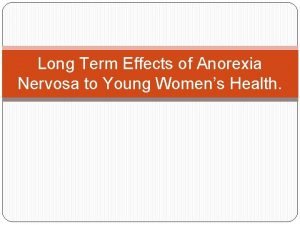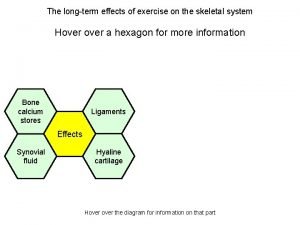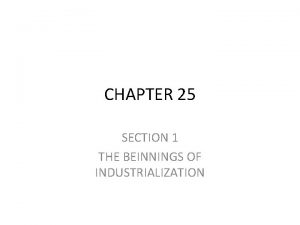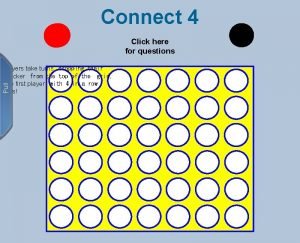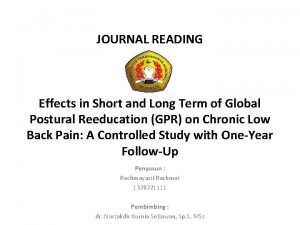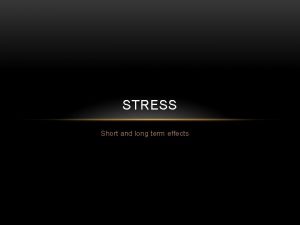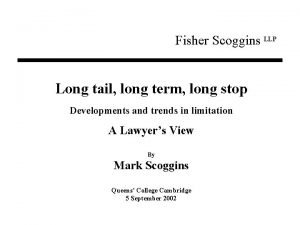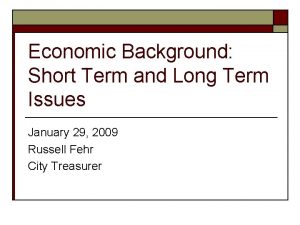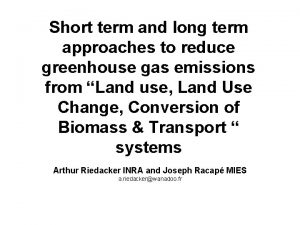Advective effects on short term and long term




















- Slides: 20

Advective effects on short term and long term Net Ecosystem Exchange C. Feigenwinter 1, C. Bernhofer 2, R. Vogt 1 , T. Grünwald 2, U. Eichelmann 2, H. Prasse 2, U. Postel 2 1 University of Basel, Institute of meteorology, climatology and remote sensing 2 TU-Dresden, Institute of hydrology and meteorology

Overview Advective effects on short term and long term Net Ecosystem Exchange C. Feigenwinter 1, C. Bernhofer 2, R. Vogt 1 , T. Grünwald 2, U. Eichelmann 2, H. Prasse 2, U. Postel 2 1 University of Basel, Institute of meteorology, climatology and remote sensing 2 TU-Dresden, Institute of hydrology and meteorology Site overview Results and conclusions MORE I Experimental setup MORE II (More measurements in the ORE mountains) Short theory and methodology Results MORE II effects of advective fluxes on NEE Conclusions and outlook

Site overview Overview anchor station Tharandter Wald Elevation 50° 58‘ N, 13° 34‘ E Landuse 375 m a. s. l. Inclination Exposition Annual mean temp. 7. 7° Annual mean precip. 819 mm

MORE I Results from MORE I (2001, DOY 263 -283) (Feigenwinter et al. , 2004, Boundary-Layer Meteorol. , in press) 00: 0008: 0016: 0024: 00 horizontal advection -1. 78 0. 80 -1. 25 -2. 23 vertical advection 1. 52 -0. 20 1. 19 2. 51 storage change -0. 08 -0. 19 0. 27 0. 00 EC flux 0. 73 -3. 00 0. 43 -1. 84 Total 0. 39 -2. 59 0. 64 -1. 56 [g C m-2 d-1] [g C m-2 period-1] ----- EC + storage change + advection terms Total day difference: 0. 18 g C m-2 d-1 (10 %)

MORE I Conclusions from MORE I Methododical problems and deficits for evaluation of the advection terms (i. e. vertical profiles of wind velocity, CO 2 concentrations and horizontal concentration gradients are strongly dependent on the experimental design) Short duration of the MORE I experiment does not allow conclusions that are generally valid. Results have to be confirmed and/or adjusted by long term measurements. Results published in: Feigenwinter, C. , Bernhofer, C. and Vogt, R. (2004): The influence of advection on the short term CO 2 budget in and above a forest canopy, Boundary-Layer Meteorology, in press. Þ MORE II Long term study (growing season) Experimental setup essentially improved Optimised coordination between measurements (gradients, wind profile, sampling rates) Adaptation of the permanent measurements according to the task

Experimental setup situation MORE I : Sep/Oct 2001 height (trees) 26 m (P 2, P 3) MORE II: Mai/Oct 2003 height (towers) 30 m (P 1, P 2, P 3) Experimental setup: Situation

Experimental setup MORE II Experimental setup: Instrumentation

Experimental setup: Tower P 1

Experimental setup: Tower P 2

Experimental setup: Tower P 3

Experimental evaluation of CO 2 exchange in a forest ecosystem I source/sink of c II storage change III turbulent flux (EUROFLUX, Aubinet et al. , 2000; FLUXNET, Agr. For. Met. Vol. 113, 2002) IV vertical advection (Lee, 1998; Baldocchi, 2000) V horizontal advection (Aubinet et al. , 2003, Staebler and Fitzjarrald, 2004; Feigenwinter et al. , 2004)

Theory and methodology Theory und methodology non turbulent advection terms vertical advection Estimation of the mean vertical wind component: sinusoidal fit over a sufficiently long period (Lee, 1998; Baldocchi et al. , 2000; Paw U et al. (2000)) or „planar fit“ (Wilczak et al. , 2001)

Theory and methodology Theory und methodology non turbulent advection terms vertical advection Estimation of the mean CO 2 concentration in the volume below the reference level: and log-square fit of the concentration profiles ● tower P 1 (30 m) ● tower P 2 (30 m) ● tower P 3 (30 m) ● main tower (anchor station)

Theory and methodology Theory und methodology non turbulent advection terms horizontal advection ___ measured gradient __ __ sonics cup anemometer

Results MORE II Results non turbulent advection terms vertical advection positive during nighttime with large scatter zero during daytime

Results MORE II Theory und methodology non turbulent advection terms horizontal advection Flow conditions during MORE II (DOY 155 -285) - mainly from SW – NW - no distinct drainage flow at night

Results MORE II Theory und methodology non turbulent advection terms horizontal advection Distribution of horizontal concentration gradients during MORE II (DOY 155 -285) - large in the lower trunk space at night - main direction NE – E - SE

Results MORE II Theory und methodology non turbulent advection terms horizontal advection Horizontal advection MORE II (DOY 155 -285) - large in the lower trunk space at night, large scatter - positive (source term)! - zero during daytime Fluxes for a layer thickness of 1 m at the resp. height 0. 5 m 2. 0 m 8. 0 m 20. 0 m 30. 0 m

Results MORE II Theory und methodology non turbulent advection terms horizontal advection Horizontal advection MORE II (DOY 155 -285) - large in the lower trunk space at night - positive (source term)! - small during daytime

Conclusions and outlook Vertical and horizontal advection are in the same order of magnitude as the turbulent EC-flux of CO 2 The large scatter of the mean advection terms is the result of a large day to day variability Including the advection terms into the NEE equation significantly increases the nightly CO 2 source and thus reduces the Carbon sink of the forest There are still many methododical problems and only a few studies for comparison. The presented results may therefore only be characterisic for the specific site
 Tall + short h
Tall + short h Short term planning and long term planning
Short term planning and long term planning Long term hr planning
Long term hr planning Difference between long term and short term liabilities
Difference between long term and short term liabilities Accounting for serial bonds
Accounting for serial bonds Long term goal
Long term goal Short term finance planning
Short term finance planning Long term memory vs short term memory
Long term memory vs short term memory Long term effects of anorexia nervosa
Long term effects of anorexia nervosa Long term effects of rape
Long term effects of rape Std crabs pics
Std crabs pics Long-term side effects of tubal ligation
Long-term side effects of tubal ligation Tinker vs des moines summary
Tinker vs des moines summary Long term effects of exercise on skeletal system
Long term effects of exercise on skeletal system Beinnings
Beinnings Once upon a time there lived a little girl name
Once upon a time there lived a little girl name Pull questions
Pull questions Tinikling costume and props
Tinikling costume and props Long long ago when the gods and goddesses
Long long ago when the gods and goddesses Junction capacitance in mosfet
Junction capacitance in mosfet Money includes
Money includes








